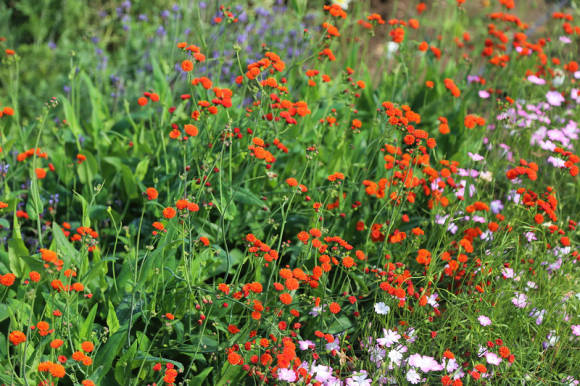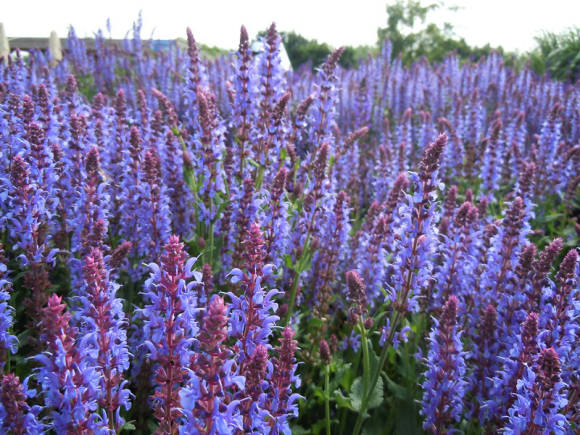
Tired of the narrow streets of Paris, you should take the 7 metro line to Buttes Chaumont or Batzaris to find yourself at the entrance to the Buttes Chaumont city park, which is 25 hectares of greenery, peace and tranquility in the middle of a big city.
Entering the park through one of five large gates, two of which are located at the named metro stations, or through one of the seven gates, we find ourselves on a shady path leading us into the world of bird chirping and serenity. Stepping out of the hustle and bustle of the metropolis into the silence of the park, you lose the sense of time. Parisians are very fond of their city parks, admission is free and unimpeded for everyone. In Buttes-Chaumont, you can sit on the lawn, get closer to any plant and even have a picnic on the grass, which is not prohibited by the rules. And its popularity among young people is also explained by the fact that here you can connect to the Internet via Wi-Fi for free, for this there are four connection points on different terraces.
Once upon a time, this place was a quarry where limestone and gypsum were mined for Parisian construction projects. The city was small in those days and the quarry was located outside of it. The city grew, the quarry was depleted, mining was stopped and the territory, which they began to call Bald Mountain, was annexed to Paris.

Under this name, it entered Russian history, because at this height in March 1814 was located the main apartment of our army, which reached Paris. From here, Alexander I examined the surroundings, turning for explanations to his adjutant, the French emigrant Count de Rochechouard, who in a few days was to become the commandant of the surrendered city. It was here that the Russian emperor, having received the news of the signing of the surrender, determined the further fate of Paris, ordering to convey to the troops that "the difference between us and the French who entered Moscow is that we bring peace, not war."
In 1863, Emperor Napoleon III instructed the mayor of Paris, Baron Haussmann, to lay out a park on the site of abandoned mine workings, which by that time had become a refuge for vagabonds and bandits. The development of the project was entrusted to Jean-Charles Alphand.

Director of public routes and manager of Parisian promenades, the famous engineer J.-Ch. Alphand has already won the confidence of the Parisians by planning the Bois de Boulogne and Vincennes. The task was set rigidly: a new park should be laid out on the site of an abandoned quarry by the 1867 World Exhibition in Paris. With the help of engineer Belgran, landscape architect Jean-Pierre Bariier-Deschamp (a couple of centuries ago, such engineers were called more precisely - builders of gardens and parks) and architect Gabriel Daviu, work was carried out on terracing four levels, laying five and a half kilometers of the roadway, replacing the top layer soil and planting of plants on 25 hectares of the acquired area.
The emperor's order was carried out. In 1867, one of the events of the international exhibition was the opening of the newly created park by Napoleon III.
The strict layout of the axes of the French regular park gave way here to the English landscape style. On the map, its outline resembles a horn in shape, and, like a true cornucopia, it is full of various surprises in a picturesque landscape park. Rocks, a lake, a grotto, a suspension bridge, Chinese and English gardens, a waterfall and a peacefully babbling brook, lawns to sit on, and paths that link together all the beauties of changing landscapes. The territory of the park is extremely diverse in terms of landscape. The main signs are reflected even in the name of the park, because the French word Buttes translates as hills, and Chaumont originated from the words "top" (chauve) and "mountain" (mont). Here you can find views for every taste: from a cliff over a lake to plain lawns , from a waterfall to a stream, quietly murmuring in the meadow.
 |  |  |
The central and highest point of the park is the Sibyl Belvedere, located on the top of a 50-meter cliff. This small stone rotunda was modeled on the ancient Roman temple of the Sibyl in Tivoli (Italy) and erected by the architect Gabriel Daviu in 1869 at the very top of the cliff in the middle of the lake. If you walk along the asphalt road that goes around the entire park, leading us through all the remarkable places of the park, then after walking five and a half kilometers along it, you will return to the place of entrance. Inside the park, there are walking paths covered with crushed gravel. Their total length is over two kilometers.
 |  |
To be faithful, we will choose the main road, and we will stop wherever we please. Our path to the cliff passes among the picturesque slopes and lawns of the upper terrace of the park. Amid the silence and bird chirping ahead, the sound of a waterfall is clearly audible. Though its concrete ledges are plain, but it is so skillfully "draped" with greenery that you can only see it while standing on the bridge above it, and its incessant good-natured muttering leaves no one indifferent.
 |  |
Then the road leads us to well-groomed lawns with magnificent cedars, where at different ends several couples, a group of young people and a mother, lulling a child in a stroller, have settled down to rest. Here you can especially understand Louis Aragon, who called this park a “legendary paradise”. Probably, this is how the birds chirped and the trees rustled for Adam and Eve.
We turn onto the path and head towards the cliff with the belvedere. Thick greenery hides another surprise from us: a stone bridge over the waters of the lake, through which you can walk to the island. This bridge was called "the bridge of suicides", they say, such cases took place here until a high fence appeared. Looking down from this bridge is truly creepy. But the brave men who received an adrenaline rush on the way to the Temple of the Sibyl will receive a reward: a beautiful view from the top of the cliff to the Louvre, Montmartre and Saint-Denis.
 |  |

After admiring Paris, we will go down and come closer to the lake. The waters of the lake are densely populated with fish, among which carp predominate, and waterfowl - ducks, geese and swans. Since fishing is prohibited here, fish fearlessly swim up to the places where vacationers feed the birds. It's funny to watch half-duck-sized carps compete successfully with birds for food. Do not be upset that you will not be able to fish, but you can rent a boat and continue walking along the lake, because it is from the water that the most picturesque view of the cascading waterfall and grotto, which are poorly visible from the shore, opens.
Having been at the top and swimming on the lake, it is worth looking into the glades of the park. Children's playgrounds and entertainment are concentrated on the lower terrace in front of the lake, but even here the noise of children's games cannot destroy the tranquility of the park. Parisians love to come here with children, because in addition to equipped playgrounds and attractions, there are two theaters waiting for them. One of them, the Guignol Anatole marionette theater, has been known to many generations of Parisians since 1892. And in September, it is in the Buttes-Chaumont park that the annual Siluete festival of short French and foreign films is held. During the week, visitors to the park can become spectators of the film festival and attend the awards ceremony.

Climbing up from the lower terrace to the upper one, from where we started our walk, it is worth taking a close look at the surrounding vegetation. Parks in Paris are partly akin to botanical gardens, and you will be able to admire the amazing plants that fill the 12 hectares of the park. Among the local flora there are also exotic representatives: Lebanese cedars, planted back in 1880, Himalayan cedar, ginkgo.
The collection of conifers alone is worth something! Luxurious Lebanese cedar (Cedruslibani) about 30 m high, which is more than a century old, proudly sways with cones on powerful branches. Deodar (Cedrusdeodara) sadly drooped the branches, as if the weight of the grown needles was heavy for him. The diverse cypress family also feels great here. (Cupressaceae) with all its many representatives.
Gingko two-bladed (Ginkgo biloba) - a relict plant full of wonders and mysteries. This tree is the progenitor of all existing conifers. It is the only gymnosperm with fan-shaped leaves, which are believed to have evolved from needles that have grown together. And if in Moscow you can still see a tree with leaves here and there, then such, hung in abundance with seeds in a fleshy peel, resembling apricots in appearance, never.
 |  |  |
Oriental plane tree (Platanus orientalis) Is one of the main tree species used for landscaping in Paris. The gray trunks of these giants, accompanying you along the boulevards of the city and keeping quiet alleys in the parks, are always decorated with light green patches of fresh bark, reminiscent of the suits of rapidly growing mischievous teenagers. And here is one of the mysteries of the park, unsolved by me. On the upper branch of the huge plane tree was attached a "pipeline" of folding wicker cones. Maybe you can guess why such a structure is needed on a plane tree?
On the descent to the asphalt circular path, a familiar bruise grew. On a steep slope (35-45 degrees) no one attempted to collect it. An abundance of bushes almost knee-high and her pristine appearance tempted her to photograph.
Another interesting plant that we met here is a huge torreya nut-bearing (Torreya nucifera) - medicinal conifer from Japan with edible cones surrounded by a fleshy layer, and therefore resembling nuts. Apparently, this is a female specimen - the cones are crowded at the ends, and not distributed at the bottom of the shoots.
 |  |
Rejecting the canons of a regular park, providing for the use of park sculpture, the Parisians perfectly fit it into the surrounding landscape. You will appreciate their skill when, in front of your eyes, as you approach, a nondescript pile of brushwood, similar to a dried bush, turns into a sculpture of a gray goblin playing a pipe on the bank of a stream, or when you shudder, looking up and seeing about ten meters away above him, a frozen man, climbing a steep slope and cautiously looking back. Only by looking closely, you realize that this is a sculpture.
 |  |
Quite modern concrete paths of the park are accompanied in places by a stream that flows along the concrete channel along the path. The channel is fenced with a relatively high side, which certainly imitates natural forms - stones, twigs, trunks. Sooner or later, she leads us to the exit, so that with fresh forces we again plunge into the noisy life of the metropolis.









